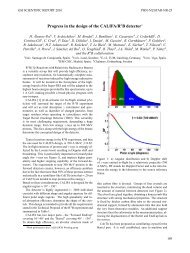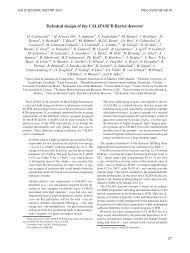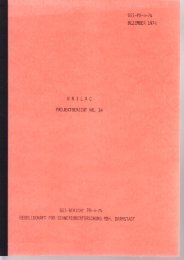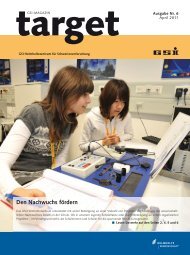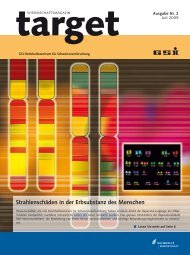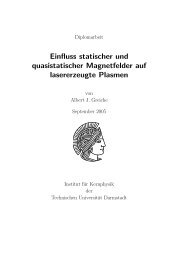download block - GSI Helmholtzzentrum für Schwerionenforschung
download block - GSI Helmholtzzentrum für Schwerionenforschung
download block - GSI Helmholtzzentrum für Schwerionenforschung
You also want an ePaper? Increase the reach of your titles
YUMPU automatically turns print PDFs into web optimized ePapers that Google loves.
<strong>GSI</strong>-UPGRADE-ACC-11 <strong>GSI</strong> SCIENTIFIC REPORT 2009<br />
Status of the SIS18 Upgrade Program and<br />
Progress in Acceleration of Intermediate Charge State Heavy Ions<br />
P. Spiller, U. Blell, L. Bozyk, H. Eickhoff, P. Hülsmann, H. Klingbeil, H. Kollmus, P. Puppel,<br />
INTRODUCTION<br />
In order to reach the desired FAIR [1] intensities for heavy<br />
ions, SIS18 has to be operated with intermediate charge states<br />
[2,3]. Operation with intermediate charge state heavy ions at<br />
the intensity level of about 10 11 ions per cycle has never been<br />
demonstrated elsewhere and requires a dedicated upgrade program.<br />
Such an upgrade program dedicated to the goal of minimizing<br />
the ionization beam loss [4] and stabilizing the dynamic<br />
residual gas pressure has been defined in 2005. So far, a major<br />
part of this upgrade program has been realized and a significant<br />
increase of the accelerated number of intermediate charge state<br />
heavy ions could be reached.<br />
STATUS OF THE UPGRADE PROGRAM<br />
Six major tasks of the upgrade program have been summarized<br />
and are realized in the frame of an EU FP6 funded construction<br />
program [5]. The tasks and their present status are<br />
summarized in Table 1.<br />
Table 1: The six upgrade tasks of the EU FP6 funded SIS18<br />
construction program and their present status.<br />
New injection system for injection of U 28+<br />
beams at 11.4 MeV/u with larger acceptance,<br />
diagnostics and protection equipment [6]<br />
New NEG coated dipole and quadrupole<br />
chambers for strong distributed pumping<br />
Ion catcher system for ionization beam loss to<br />
minimize the effective gas desorption [7]<br />
New h=2 acceleration cavity for fast acceleration<br />
in a two harmonic bucket<br />
New TK stripper system for high charge state<br />
operation<br />
Fast residual gas profile monitor for turn by<br />
turn beam profile measurements<br />
H. Ramakers, H. Reich-Sprenger<br />
<strong>GSI</strong> Darmstadt, Germany<br />
Completed<br />
Completed<br />
Completed<br />
Ongoing<br />
Completed<br />
Ongoing<br />
The new power grid connection of the <strong>GSI</strong> pulse power network,<br />
which has been completed in 2006, enables ramping of<br />
SIS18 with high ramp rates without constrains. High ramp rates<br />
are significantly contributing to the goal of minimizing the<br />
ionization beam loss and stabilising the dynamic residual gas<br />
pressure at intermediate charge state operation.<br />
STATUS OF INTERMEDIATE CHARGE<br />
STATE, HEAVY ION OPERATION<br />
First experiments with high intensity, intermediate charge<br />
state heavy ion beams have been performed in 2001. At this<br />
time, most of the injected 10 10 U 28+ -ions have been lost by<br />
ionization in the residual gas within a few hundred milliseconds<br />
(Figure 1). Fast pressure bumps initiated by initial systematic<br />
beam loss, drove a strong residual gas pressure dynamic, which<br />
itself has amplified this loss process. Meanwhile, the ionization<br />
beam loss could significantly been reduced and acceleration<br />
156<br />
and extraction of about 10 10 ions has been demonstrated with<br />
U 27+ and Ta 24+ ions. Figure 1 shows the intensity profile in an<br />
acceleration cycle with U 28+ and U 27+ beams in 2001 and 2009.<br />
Figure 1: SIS18 acceleration cycle with intermediate charge<br />
state Uranium ions in 2009 and 2001. Beam loss by ionization,<br />
which is by far the dominating loss mechanism, could be significantly<br />
reduced and the number of extracted ions increased<br />
by a factor of 70.<br />
The following measures have contributed to this progress:<br />
� Injection at higher energy (11.4 MeV/u instead of 7.1<br />
MeV/u with lower ionization cross section.<br />
� Acceleration with higher ramp rates (4 T/s instead of 1.3<br />
T/s) and correspondingly shorter cycle times<br />
� Careful optimization of the acceleration cycle in terms of<br />
systematic beam loss at multi turn injection and RF capture<br />
loss<br />
� At the time of the machine experiments the UHV upgrade<br />
and the set-up of the scraper system was only partially<br />
completed and have to a certain extend contributed to the<br />
stabilization of the vacuum pressure.<br />
Further improvement has been achieved in the time averaged<br />
number of accelerated heavy ions. While the progress in accelerated<br />
Ta-ions per cycle could only be achieved with breaks of<br />
9 seconds in between two cycles, the breaks at the Uranium run<br />
could be reduced to one second only.<br />
REFERENCES<br />
[1] P. Spiller, “FAIR at <strong>GSI</strong>”, Proc. of HB2006, (2006)24<br />
[2] P. Spiller et al, Proc. of PAC09 (2010)<br />
[3] C. Omet et al, Proc of PAC07 (2008)1416<br />
[4] G. Weber et al, Phys RevSTAB.12,084201 (2009)<br />
[5] Description of work, DOW_CNI-515876_20050705<br />
[6] U. Blell et al, Proc. of PAC07 (2008)167<br />
[7] C. Omet et al, New Journal of Physics 8 (2006)284





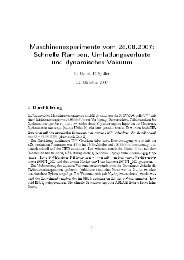
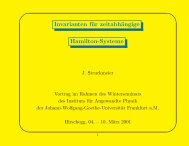
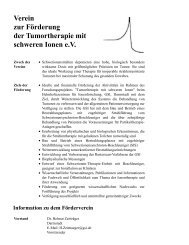
![GS I -P-]-17 - GSI Helmholtzzentrum für Schwerionenforschung](https://img.yumpu.com/20698964/1/184x260/gs-i-p-17-gsi-helmholtzzentrum-fur-schwerionenforschung.jpg?quality=85)

